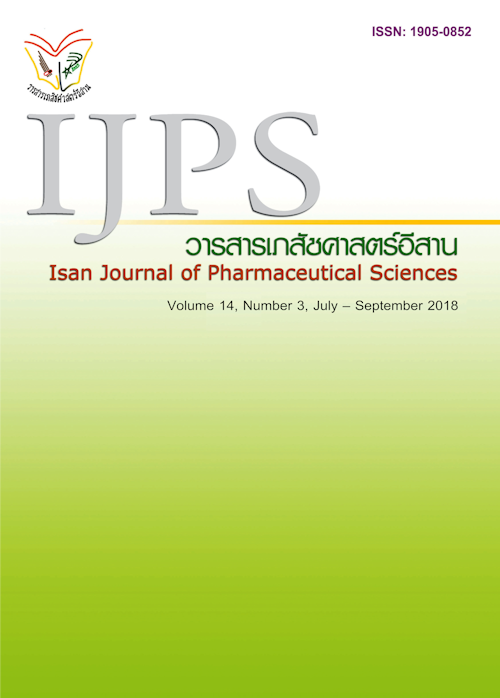Meta-Analysis on Effectiveness of Psyllium (Plantago ovata Forsk.) Plus Lipid Lowering Agent on Hyperlipidemic Patients
Main Article Content
Abstract
The psyllium (Plantago ovata Forsk.) is a soluble fibers was used as complementary medicine. The previous studies found that psyllium improved lipid profile in hyperlipidemic patients. Data from The US Food and Drug Administration (FDA) approved for psyllium when included in a low saturated fat and cholesterol diet, also helps to lower total cholesterol (TC) and low density lipoprotein (LDL) levels. However, there were no a meta-analysis of effectiveness of psyllium plus lipid lowering agent for hyperlipidemic patients. The objective of this study was to systematically review literature and conduct the meta-analysis of the effectiveness of psyllium plus lipid lowering agent for controlling blood lipid. Methods: The researcher retrieved articles via electronic databases such as Pubmed, Web of Science, CINAHL, Allied and Alternative Medicine Database (AMED) and Hand searching. Randomized controlled trials (RCT) reported in English or Thai and publish until 31 January 2018 were used in data analysis. Results: The quality of 4 included studies was assessed according to the Jadad criteria. The quality of the most the included studies was high with the score between 3 and 5. The most of studies conducted in moderate hypercholesterolemia with dose of psyllium ranged from 5-15 g/day. The number of participants in the studies ranged from 27-121. The study found that psyllium plus lipid lowering agent (cholestyramine 4 g/day 1 study, Colestipol 2.5 g/day 1 study and HMG CoA reductase inhibitors 2 studies were simvastatin 10, 20 mg/day and Lovastatin 20 mg/day) could statistically significant reduced the level of low density lipoprotein (LDL) 30% from baseline (weight mean difference; WMD= -7.89 mg/dL; 95%CI: -14.63 to -1.15 mg/dL; p=0.02) and total cholesterol (TC) (WMD = -7.10 mg/dL; 95% CI: -11.32 to -2.88 mg/dL; p=0.001). There were no statistically significant differences in high density lipoprotein (HDL) and triglyceride (TG). No serious adverse events (such as nausea, bloating) from psyllium plus lipid lowering agent had been found during the studies. Conclusion: This meta-analysis revealed that psyllium plus lipid lowering agent effectively reduce LDL and TC. However, a large RCT should be conducted to confirm the results of the meta-analysis.
Article Details
In the case that some parts are used by others The author must Confirm that obtaining permission to use some of the original authors. And must attach evidence That the permission has been included
References
Agrawal AR, Tandon M, Sharma PL. Effect of combining viscous fibre with lovastatin on serum lipids in normal human subjects. Int J Clin Pract 2007;61(11):1812-8.
Anderson JW, Allgood LD, Lawrence A, et al. Cholesterol-lowering effects of psyllium intake adjunctive to diet therapy in men and women with hypercholesterolemia: meta-analysis of 8 controlled trials. Am J Clin Nutr 2000;71(2):472-9.
Brown L, Rosner B, Willett WW, et al. Cholesterol-lowering effects of dietary fiber: a meta-analysis. Am J Clin Nutr 1999;69(1):30-42.
Chapman MJ, Ginsberg HN, Amarenco P, et al. Triglyceride-rich lipoproteins and high-density lipoprotein cholesterol in patients at high risk of cardiovascular disease: evidence and guidance for management. Eur Heart J 2011;32(11):1345-61.
Davidson JA, Parkin CG. Is hyperglycemia a causal factor in cardiovascular disease?. Diab Care. 2009; 32 (Suppl 2): s331–s333
Grundy SM, Cleeman JI, Daniels SR, et al. Diagnosis and management of the metabolic syndrome an American heart association/ national heart, lung, and blood institute scientific statement. Curr Opin Cardiol 2006;21(1):1-6.
Higgins JPT, Altman DG, Gøtzsche PC, et al. The Cochrane Collaboration’s tool for assessing risk of bias in randomised trials. BMJ 2011;343:d5928 doi: 10.1136/bmj.d5928
Higgins, JPT, Green S. Cochrane handbook for systematic reviews of interventions version 5.1.0 (updated March 2011): The Cochrane Collaboration; 2011 [online]. 2011[cited Nov 11, 2017] Available from: www.cochrane-handbook.org.
Jadad AR, Moore RA, Carroll D, et al. Assessing the quality of report of randomized clinical trials: is blinding necessary? Control Trials 1996; 17:1-12.
Maciejko JJ, Brazg R, Shah A, et al. Psyllium for the reduction of cholestyramine-associated gastrointestinal symptoms in the treatment of primary hypercholesterolemia. Arch Fam Med 1994; 3(11):955-60.
Moher D, Liberati A, Tetzlaff J, et al. Preferred reporting items for systematic reviews and meta-analyses: the PRISMA statement. Ann Intern Med 2009;151: 264–8.
Moreyra AE, Wilson AC, Koraym A. Effect of combining psyllium fiber with simvastatin in lowering cholesterol. Arch Intern Med 2005;165(10):1161-6.
Olson BH, Anderson SM, Becker MP, et al. Psyllium-enriched cereals lower blood total cholesterol and LDL cholesterol, but not HDL cholesterol, in hypercholesterolemic adults: results of a meta-analysis. J Nutr 1997;127(10):1973-80.
Pal S, Radavelli-Bagatini S. Effects of psyllium on metabolic syndrome risk factors. Obes Rev. 2012;13(11):1034-47.
Sahebkar A. Are curcuminoids effective C-reactive protein-lowering agents in clinical practice? Evidence from a meta-analysis. Phytother Res 2014; 28(5):633-42.
Spence JD, Huff MW, Heidenheim P, et al. Combination therapy with colestipol and psyllium mucilloid in patients with hyperlipidemia. Ann Intern Med 1995;123(7):493-9.
Stone NJ, Robinson J, Lichtenstein AH, Bairey CN, Blum CB, Robert H, et al. 2013 ACC/AHA Guideline on the Treatment of Blood Cholesterol to Reduce Atherosclerotic Cardiovascular Risk in Adults. Circulation. 2013;01.cir.0000437738.63853.7a
US Food and Drug Administration. [homepage on the Internet]. Title 21--food and drugs chapter I--food and drug administration department of health and human services subchapter b--food for human consumption. [updated 2017 Aug 14; cited 2017 Apr 28]. Available from: https://www.accessdata.fda.gov/scripts/cdrh/cfdocs/cfcfr/cfrsearch.cfm?fr=101.81.


